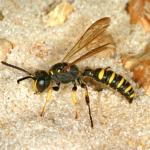Ecological studies in the Norfolk Brecklands (Field & Foster, 1995; Willmer, 1985a,b) and Europe (Hamm & Richards, 1930) make this one of the best-known British aculeates.
A locally common and very widely distributed species throughout much of southern Britain. It also occurs on the larger Channel Islands.
This species is not regarded as being threatened.
This wasp is associated with sandy soils and can be locally common to abundant on inland heaths and commons, and on the coast (especially dunes and landslips).
In Britain the species is univoltine, and in the south is typically active from the end of June/early July until mid- to late August.
Adult weevils (Curculionidae), particularly Otiorhynchus and Strophosoma in Britain. Other beetle families have been recorded elsewhere (Lomholdt, 1976).
Nests are deep burrows dug in the soil, from which side-tunnels radiate leading to cells at depths of 20-25 cm. In sandy areas, dense aggregations containing thousands of nests may form. Each cell is provisioned with 3-14 prey, the number depending on prey size and sex of offspring. A colony of 1000 nests must cull around 100,000 weevils each year (Willmer, 1985a). Paralysed weevils are carried in flight, and are probably stored temporarily somewhere in the burrow until enough have been accumulated to fill a cell. The prey are then moved into a cell and an egg laid on one of them. Nests are left open and unoccupied through most of the day, and nest-less ‘searcher’ females often usurp them. Some searchers, on entering a nest, immediately close it at the entrance with a plug of soil: when the owner returns, she tries to dig through the closure, but sometimes fails to do so. The old owner then becomes a searcher, and has to find another female's nest to usurp, or occasionally that of a different species, such as the bee Dasypoda hirtipes. Some 10-15% of nests are usurped each day, each nest being sequentially occupied by many different females. Usurpers are not always successful, however, and may be evicted or killed by the owner (Field & Foster, 1995).
On hot days, females visit flowers (e.g. white melilot - Melilotus alba), more for water than sugars.
In the Brecklands, C. arenaria cells rarely appear to be parasitised by chrysidid wasps or miltogrammine flies (Field & Foster, 1995). Elsewhere, the chrysidid, Hedychrum niemelai, is a cleptoparasite.
1997
Proofed: March 2012


